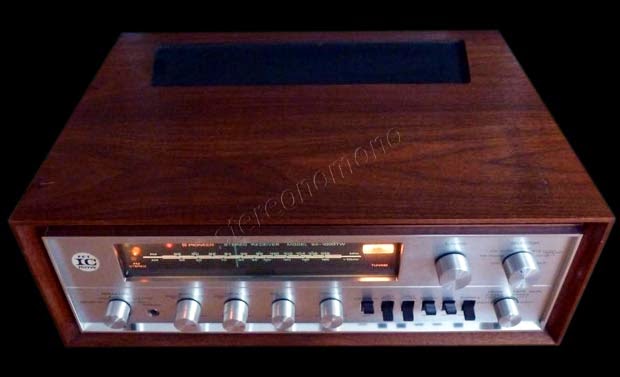Pioneer
Solid State AM/FM Stereo Receiver model SX-1000TW
Some Unique
Features
FM front-end
employing a field effect transistor to hear more stations more clearly.
By the use
of FET in the FM radio frequency amplifier stage, design of nearly perfect FM
front-end was achieved-free from cross modulation, free from drift, with better
sensitivity, lower inherent noise, and high spurious rejection ratio.
Integrated
circuit (IC) employed in FM tuner assures outstanding capture ratio with high
reliability.
In the FM
intermediate frequency amplifier stage, integrated circuits are employed,
resulting in an entirely different outstanding performance from that of IF
stages hitherto designed, especially in the limiter characteristic and the
capture ratio.
Multiplex
circuitry (PMX) for maximum channel separation.
The accurate
electronic switching circuitry is employed in the FM multiplex demodulator,
insuring maximum separation with excellent tonal quality.
Unique
muting circuitry permits the easiest tuning control.
The muting
circuit provided in the FM tuner completely eliminates the FM inter-station
noise which has hitherto been annoying the user in tuning.
High
performance single ended push-pull (SEPP) output stage eliminates audio
transformers and provides large output with true frequency fidelity.
The power
amplifier employs the high-performance single ended push-pull circuitry in the
output stage and the push-pull complementary circuitry in the driver stage,
completely eliminating the distortion inherent transformers from the audio
stage. Tripple diffused mesa transistors are adopted as the power transistors
in the output stage for full-fidelity frequency response with large audio
output power and least harmonic distortion.
Full
complement of inputs and outputs.
The inputs
and outputs provided in the receiver include two pairs of Phono Mag inputs.
When two turntables are connected to these inputs, the user is able to switch
from one turntanble to the other any time
at will. Also, two pairs of loudspeaker output are included for
switching between, or for permitting the simultaneous use of, two loudspeakers.
Electronic
switch fully protects the precious power transistors.
The
electronic switching circuitry employed in the power supply completely protects
expensive power transistor even when the loudspeaker leads are shorted while
the receiver unit is in use.
Specifications
FM Tuner
Section
Circuitry: Front-end using FET and 4 gang variable air
capacitor, IF amplifier using 4 IC
Frequency
Range: 87 - 108 MHz
IHF Usable
Sensitivity: 1,7 µV
Image
Rejection: 76 dB (at 98 MHz)
Signal-to-Noise
Ratio: 65 dB (IHF Rating)
Capture
Ratio: 1 dB (at 98 MHz)
Antenna
Input: 300 Ω (balanced)
MPX Section
Circuitry: Time-switching type de-modulator FM Mono
Stereo Automatic selection
Channel
Separation: 37 dB (at 1 kHz)
AM Tuner
Section
Circuitry: Superheterodyne
Frequency
Range: 525 - 1605 kHz
IHF Usable
Sensitivity: 20 µV
Image
Rejection: 60 dB (at 1000 kHz)
Antenna
Input: Built-in Ferrite Loopstick
antenna
Audio
Section
Circuitry: Single ended push-pull
Music Power
Output (total IHF rating):
130
watts at 8 Ω
150
watts at 4 Ω
RMS
Rated Power Output: 50 watts per channel
at 8 Ω
Frequency
Response: 20 Hz - 50 kHz (Over-all) ±1
dB
Harmonic
Distortion: less than 0,5% at 1 kHz
rated output
Power
Bandwidth: 15 Hz - 50 kHz (Aux)
Hum and
Noise (at rated output):
Tape head
: better than 75 dB
Mag : better than 80 dB
Aux : better than 90 dB
Inputs
Sensitivity/ Impedance (for rated output):
Magnetic
Phono : 2,4 mV/50 k Ω
Ceramic
Phono : 51 mV/90 k Ω
Tape
head : 1,5 mV/120 k Ω
Tape
Monitor : 200 mV/100 k Ω
Auxiliary: 200 mV/100 k Ω
Damping
Factor: 25 (8 Ω, 1 kHz)
Output
Terminals and Jacks: Stereo headphone
jack, Simultaneous tape Recording jacks, equipped with Tape Monitor switch,
tape recording/playback jack (DIN standards)
Equalization
Curves:
Phono : RIAA
Tape : NAB
Tone
Controls (each channel):
Bass : boost 12 dB, cut 14 dB at 50 Hz
Treble
: boost 10 dB, cut 11,5 dB at 10 kHz
Filters:
Low : cut 6 dB at 50 Hz
High : cut 10 dB at 10 kHz
Loudness
Contour: Switchable to On-Off boost 12
dB at 50 Hz, boost 6,5 dB at 10 kHz, with Volume control set at -40 dB
Semiconductors
Tuner
Section: 4 ICs; 1 FET; 15 Transistors;
17 Diodes
Audio
Section: 27 Transistors; 17 Diodes and
etc.
Miscellaneous
Power
Requirements: 110, 112, 130, 220 V and
240 V (switchable) 50/60 Hz
Power
Consumption: 285 VA, 255 W (max)
Dimensions
(W x H x D): 405 x 137 x 350 mm
(15-15/16" x 5-3/8" x 13-3/4")
Weight
[without/with package]: 10,6 kg (23 lb)
/ 13,3 kg (29 lb)






Nessun commento:
Posta un commento